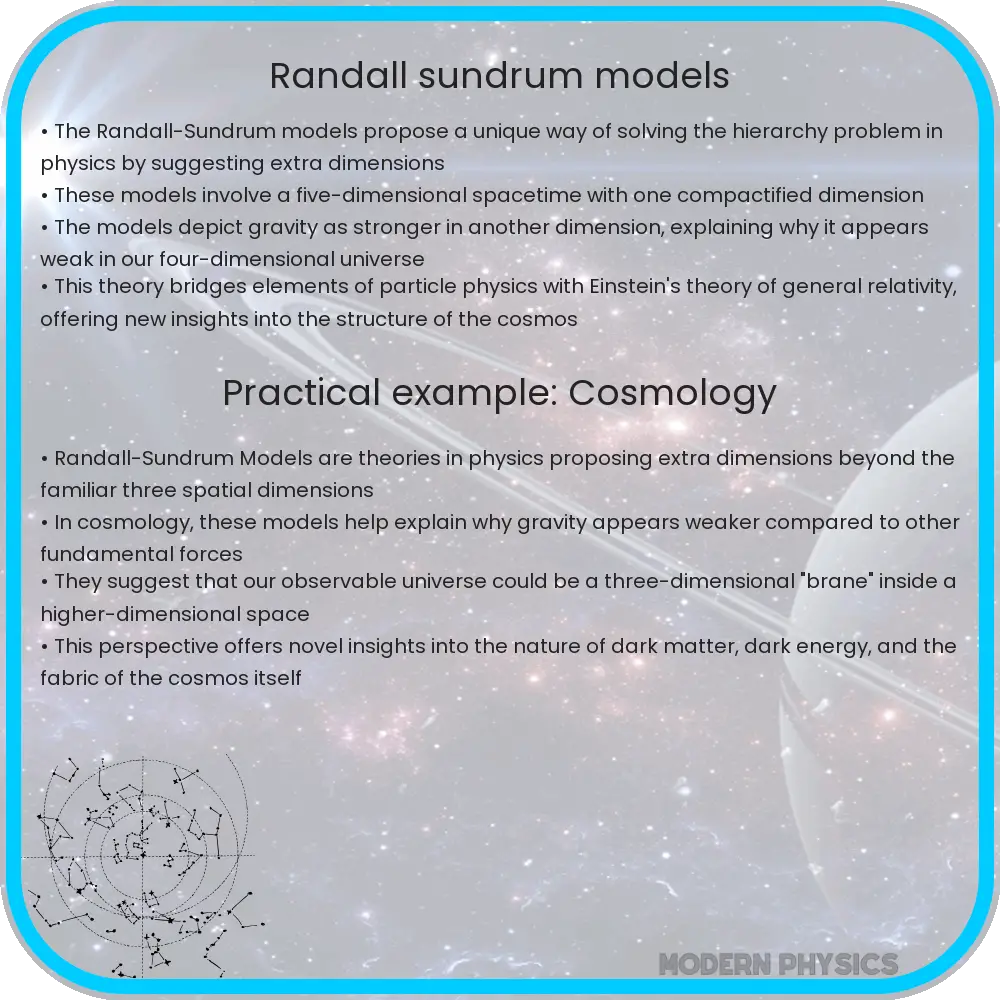Explore the Randall-Sundrum models: innovative theories addressing the hierarchy problem with extra dimensions, impacting cosmology, particle physics, and string theory.

Understanding Randall-Sundrum Models: A Dive into Advanced Physics
The Randall-Sundrum (RS) models, proposed by physicists Lisa Randall and Raman Sundrum, represent a significant breakthrough in theoretical physics, offering a novel approach to resolving the hierarchy problem in particle physics. This fascinating concept bridges the realms of gravity, higher dimensions, and cosmology, challenging our traditional perceptions of the universe’s structure.
Exploring the Hierarchy Problem
The hierarchy problem in particle physics questions why gravity is exponentially weaker than the other three fundamental forces. In the Standard Model of particle physics, the vast difference between the gravitational force and the other forces remains unexplained. The Randall-Sundrum models provide an innovative solution to this conundrum by introducing extra dimensions beyond the familiar three-dimensional space.
The Framework of Randall-Sundrum Models
Central to the RS models are the concepts of warped geometry and extra dimensions. The models propose that our universe is a five-dimensional space-time, consisting of a single, “warped” extra dimension beyond our familiar three-dimensional space and one-time dimension. This extra dimension is not infinite but rather is compactified, meaning it is curved in such a way that it has a finite size.
The RS models come in two main variants: RS1 and RS2. The RS1 model suggests that the extra dimension is sandwiched between two branes — thin membranes with different physical properties. Our universe is envisaged as one of these branes, where the standard particles and forces except gravity are confined, while gravity can propagate into the extra dimension. This setup explains why gravity appears so weak: it is diluted across the additional dimension.
The RS2 model modifies this framework by considering only one brane and an infinite extra dimension. In this scenario, gravity still leaks into the extra dimension but decays rapidly enough that its strength remains concentrated near the brane. This model provides intriguing insights into the possible localization of gravity and has implications for cosmology and the early universe.
These models have profound implications for our understanding of the universe, influencing not only theoretical physics but also inspiring new directions in cosmology and string theory.
Implications and Applications of Randall-Sundrum Models
The Randall-Sundrum models, while primarily theoretical, have wide-ranging implications that extend into various domains of physics. One of the most significant applications is in the realm of particle physics, where these models offer potential explanations for the mass hierarchy of elementary particles. By modifying the fundamental scales at which different forces act, the RS models could explain why the weak force is much stronger than gravity at short distances.
In addition to providing solutions to the hierarchy problem, the RS models influence our understanding of cosmology. They offer a new perspective on the early universe’s inflationary period, potentially addressing unresolved questions related to dark matter and dark energy. The models also propose alternative scenarios for the Big Bang and the overall evolution of the universe.
Furthermore, the RS models have a significant impact on string theory, where they serve as a bridge between theoretical mathematics and observable physics. By incorporating extra dimensions, these models offer a framework within which string theory’s complex landscape can be related to real-world phenomena, enhancing its testability and relevance.
Challenges and Future Directions
Despite their promising aspects, the Randall-Sundrum models also face challenges and criticisms. One major issue is the lack of direct experimental evidence. While the Large Hadron Collider (LHC) and other high-energy physics experiments may potentially uncover signs of extra dimensions, definitive proof remains elusive. Moreover, the mathematical complexity and speculative nature of these models mean that they require further refinement and validation.
Future research in this area is likely to focus on finding empirical support for the RS models and exploring their implications in greater depth. This includes precision tests at particle colliders, cosmological observations, and theoretical studies aimed at integrating these models more fully with other areas of physics.
Conclusion
The Randall-Sundrum models represent a fascinating and innovative approach to some of the most profound questions in physics. By proposing extra dimensions and a warped space-time geometry, they offer potential solutions to the hierarchy problem and open up new avenues for understanding the universe’s structure and origins. While challenges remain, particularly in terms of empirical validation, the RS models continue to inspire theoretical exploration and hold promise for advancing our grasp of the cosmos. As research progresses, these models may either pave the way for a deeper theoretical framework or stimulate the development of alternative theories that further our quest to understand the fundamental nature of reality.
